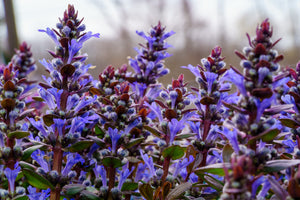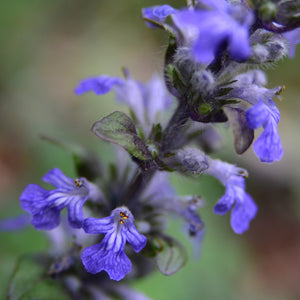The Ajuga Guide
Ajuga, also known as bugleweed, is a genus of herbaceous flowering plants native to Europe, Asia, and Africa. These ground-covering perennials are cherished for their vibrant foliage and striking, tubular flowers that bloom from late spring to early summer. Ajuga plants are available in various sizes and colors, with leaves ranging from deep green to striking purple, bronze, or variegated patterns. They are versatile and resilient plants, ideal for adding color and texture to garden beds, borders, or as a lush ground cover in shady areas. Here's what you need to know about planting and caring for Ajuga plants:

About
Ajuga, a captivating genus within the Lamiaceae family, is renowned for its striking beauty and ecological contributions. Encompassing over 40 species, Ajuga plants are predominantly found across Europe, Asia, and Africa, enhancing the botanical richness of various landscapes. These herbaceous perennials are distinguished by their low-growing, mat-forming habit and eye-catching foliage that ranges from deep greens to purples, bronzes, and variegated patterns.
One of the most appealing features of Ajuga is its vibrant display of tubular flowers that bloom in late spring to early summer, showcasing hues of blue, purple, pink, and white. This floral display not only adds a splash of color to gardens but also serves as an important nectar source for pollinators such as bees, butterflies, and hummingbirds. The dense foliage of Ajuga also provides ground cover, reducing soil erosion and offering habitat for small insects and other wildlife.
Ajuga plants are incredibly versatile and adaptable, thriving in a variety of soil types and environmental conditions. They prefer moist, well-drained soil and can flourish in both full sun and partial shade, making them ideal for a wide range of garden settings. Their ability to form dense carpets of foliage makes them perfect for use as ground covers, in shaded garden areas, under trees, or along garden borders.
Popular species within the Ajuga genus include Ajuga reptans, commonly known as carpet bugleweed, and Ajuga genevensis, each offering unique characteristics and visual appeal. Ajuga reptans, in particular, is favored for its vigorous growth and ability to quickly establish a lush, green carpet that suppresses weeds and enhances garden aesthetics.
Incorporating Ajuga into your garden not only elevates its visual charm but also supports local ecosystems by providing resources and habitat for beneficial pollinators and other wildlife. Embrace the diversity and resilience of Ajuga and create a garden that harmonizes with the natural rhythms of the environment.

Planting
Ajuga requires careful planting and care to ensure successful establishment and robust growth. Here are essential guidelines for planting and caring for Ajuga:
Soil: Ajuga thrives in well-draining soil rich in organic matter. It prefers a slightly acidic to neutral pH range, typically between 6.0 and 7.0. To create an optimal planting environment, prepare the site by loosening the soil and incorporating generous amounts of compost or organic matter. This enhances drainage, boosts fertility, and provides a nutrient-rich foundation for the Ajuga.
Sunlight: Ajuga plants prefer partial to full shade but can tolerate some sun, especially in cooler climates. When selecting a planting location, prioritize areas that receive dappled sunlight or morning sun with afternoon shade. In hotter regions, Ajuga benefits from more shade to prevent leaf scorch and maintain vibrant foliage.
Watering: Adequate and consistent watering is crucial, especially during the initial stages of Ajuga establishment. Deeply water the plant immediately after planting and continue with regular irrigation throughout the first growing season. Aim for deep and thorough watering once or twice a week, depending on rainfall and soil moisture levels. Be careful to avoid overwatering, as excess moisture can lead to root rot.
Mulching: Applying a layer of organic mulch around the base of the Ajuga offers multiple benefits. Mulch helps conserve soil moisture, suppress weed growth, and regulate soil temperature. Utilize materials such as wood chips, bark, or compost as mulch. Maintain a gap of a few inches between the mulch and the plant's crown to prevent excess moisture accumulation around the plant's base.
Pruning: Ajuga typically requires minimal pruning. Focus on removing any dead, damaged, or diseased foliage to maintain a healthy and attractive appearance. The ideal time for pruning is in late winter or early spring before new growth emerges. This ensures minimal stress on the Ajuga and promotes vigorous development.
By adhering to these fundamental planting and care guidelines, you can facilitate the successful establishment and robust growth of your Ajuga plants. These practices will contribute to the longevity and beauty of your landscape, allowing Ajuga to thrive and enhance your outdoor space for years to come.

Care
Ajuga requires specific care practices to ensure optimal growth and vitality. Here are comprehensive guidelines for the care of Ajuga, ensuring it graces your garden with enduring beauty:
Watering: During the growing season, offer moderate and consistent watering to your Ajuga. Aim for approximately one inch of water per week, adjusting based on natural rainfall. It is crucial to water deeply and thoroughly, encouraging robust root development. Shallow watering should be avoided, as it can induce stress and dehydration. In periods of drought or elevated temperatures, additional watering may be necessary to maintain adequate soil moisture.
Pruning: Ajuga generally requires minimal pruning, but selective care enhances its overall health and aesthetic appeal. Remove any dead, damaged, or diseased foliage to preserve the plant's vitality and appearance. Pruning is best done during late winter or early spring before the onset of new growth. Employ clean, sharp pruning tools to minimize the risk of harm to the plant. Deadheading spent flowers can stimulate new growth and potentially trigger a second blooming, contributing to a prolonged flowering season.
Fertilizing: Fertilization plays a pivotal role in promoting vibrant growth and abundant flowering in Ajuga. Apply a balanced, slow-release fertilizer in the spring or early summer, adhering to the recommended application rates and timing specified by the manufacturer. Exercise caution to avoid over-fertilizing, as it can negatively impact the plant's root system. When uncertain, opt for a conservative approach and use less fertilizer, ensuring the health and longevity of your Ajuga.
Soil and Sunlight: Ajuga thrives in well-drained, moist soil and prefers partial to full shade. While it exhibits tolerance to diverse soil types, ensuring optimal drainage is essential for its well-being. Mulching around the base of the plant contributes to moisture retention and regulates soil temperature, creating a conducive environment for healthy growth.
Pests and Diseases: Though generally resilient, Ajuga can face challenges from pests such as aphids, spider mites, and whiteflies. Vigilance is key—monitor your plants for signs of damage or disease. Swift action with appropriate insecticides or fungicides, when necessary, will help safeguard the health and vitality of your Ajuga. Additionally, proper spacing and good air circulation can help prevent fungal issues such as powdery mildew.
By adhering to these holistic care guidelines, your Ajuga will flourish, becoming a perennial source of beauty and lush greenery in your garden for many years to come.

How To Use
Ajuga's versatile nature offers a wealth of possibilities to enrich your landscape. Tailor its characteristics to your advantage with these insightful recommendations:
Ground Cover Delight: Ajuga’s dense, mat-forming habit makes it an excellent choice for ground cover. Plant it in areas where you want to suppress weeds and add a lush, colorful carpet. It’s especially effective on slopes and in shaded areas under trees where grass struggles to grow.
Pathway Accents: Define the edges of your garden paths with the elegance of Ajuga. Its compact and spreading growth creates a soft, colorful border along walkways, adding texture and visual interest. The contrast of its foliage against hardscape elements like stone or brick can create a striking effect.
Container Gardening: Explore creative container gardening by cultivating Ajuga in pots or containers. This allows you to move these delightful plants to different areas, adding bursts of color to patios, decks, or even balconies. Ajuga’s trailing habit can spill over the edges of containers, creating a cascading effect.
Mixed Borders: Integrate Ajuga into mixed borders for a dynamic display of color and texture. Its vibrant foliage and seasonal flowers complement a variety of other plants. Pair Ajuga with perennials, shrubs, and annuals to create visually pleasing and ecologically supportive plant communities.
Underplanting: Use Ajuga as an underplanting beneath taller shrubs and trees. Its ability to thrive in partial to full shade makes it an ideal companion for filling in bare spots and adding interest to shaded garden areas. The colorful foliage of Ajuga can provide a beautiful contrast to the green canopy above.
Erosion Control: Ajuga’s spreading growth habit and dense root system make it an effective plant for erosion control on slopes and embankments. Plant it in areas prone to soil erosion to stabilize the soil and prevent runoff while adding aesthetic value to the landscape.
Whether you're seeking a ground cover, a pathway accent, a container feature, or an underplanting companion, Ajuga brings vibrancy and versatility to your landscape. Consider its spreading habit, delightful foliage, and adaptability when planning your garden. With Ajuga, you're not just landscaping; you're crafting a masterpiece that evolves with the seasons, adding a touch of sophistication to your outdoor haven.
Conclusion
Ajuga is a versatile and visually stunning plant that brings a touch of elegance and resilience to any garden. With its vibrant foliage, striking flowers, and low-maintenance nature, Ajuga is an ideal choice for ground cover, borders, containers, and more. Its adaptability to various soil types and light conditions makes it a reliable and attractive addition to your landscape. By following the guidelines for planting, caring, and utilizing Ajuga in your garden, you can create a lush, colorful, and thriving outdoor space. Embrace the beauty and functionality of Ajuga, and enjoy the dynamic transformation it brings to your garden throughout the seasons.














